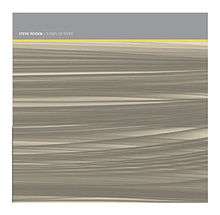Forms of Paper
Forms of Paper is an experimental musical work by Steve Roden created solely from heavily distorted sounds of paper being handled. It is a prominent album in the lowercase genre of music.[2]
| Forms of Paper | ||||
|---|---|---|---|---|
 | ||||
| Studio album by | ||||
| Released | October 2001[1] | |||
| Genre | Lowercase | |||
| Length | 54:01 | |||
| Label | Line | |||
| Steve Roden chronology | ||||
| ||||
| Alternative cover | ||||
.jpg) Cover of the 2011 Remastered version | ||||
Development
Forms of Paper was recorded and composed using a computer; a first for Steve Roden. The audio was recorded using regular and contact microphones to record the sounds of rubbing, scraping and otherwise manipulating paper. The recorded sounds were then edited with changes to the equalization and heavy use of repetition.[3]
The work was originally commissioned by the Hollywood branch of the Los Angeles public library for the exhibition "Six Degrees - Art in the Libraries". A ten-minute version of the track was played softly continuously for a month from eight speakers atop a pedestal covered with the modified pages from a discarded science book.[4][3] The CD version was expanded and reworked to be nearly an hour long.[5] Only 500 CDs were made of this version and released.
Remaster
Despite praise for the album, Roden was initially displeased with the CD release, feeling that the mastering done by Taylor Deupree was too high volume.[6] A remaster was made by Bernhard Günter later that year which better matched Roden's expectations. Although originally just intended for Roden's personal use, Roden allowed Line to release Günter's remaster for the 10 year anniversary of the original release.[7]
Packaging
The re-release was accompanied by an essay On lowercase Affinities and Forms of Paper, serving as liner notes.
The remastered version uses a different cover than the original release. The new cover uses a photograph of paper ostensibly from the original L.A. Public Library exhibition. A larger version of the same photograph in the liner notes shows the page is titled Melting Point Index of Organic Compounds (Continued).
Track listing
All tracks are written by Steve Roden.
| No. | Title | Length |
|---|---|---|
| 1. | "Forms of Paper" | 54:01 |
References
- "forms of paper (bernhard gunter remaster)". steve roden. 2011. Retrieved 2020-06-08.
- Leander Kahney (2002-05-29). "Whisper the Songs of Silence". Wired.com. Retrieved 2020-06-16.
- Roden, Steve (2011). "On Lowercase Affinities and Forms of Paper" (PDF). Retrieved 2020-06-12.
- "steve roden forms of paper installation". Inbetweennoise.com. Archived from the original on 2011-09-26. Retrieved 2012-02-16.
- "steve roden forms of paper". Inbetweennoise.com. Archived from the original on 2011-09-26. Retrieved 2012-02-16.
- Roden, Steve (2011). "On Lowercase Affinities and Forms of Paper" (PDF). p. 7. Retrieved 2020-06-08.
Truth be told, the first time I heard it, I was not happy. Because I tended to mix my own work at a relatively quiet level, the mastering process necessitated upping the gain, which brought out a number of sounds that I had never even heard.
- Roden, Steve (2011). "On Lowercase Affinities and Forms of Paper" (PDF). p. 7. Retrieved 2020-06-08.
While I had no interest in the piece ever being re-released, I gave him [Günter] a copy of my final mix and a few months later he sent back his take, which sounded a thousand times better. [...] When I realized that October 2011 would the [sic] 10 year anniversary of forms of paper’s initial release, it seemed time a good time to reconsider — particularly because I have gotten more requests for a copy of forms of paper than any of my other releases, I decided to finally re-listen to Bernhard’s remastered... and remarkably — with all of the distance between us — this piece of mine and me, seemed to feel as if we might finally be able to get along.